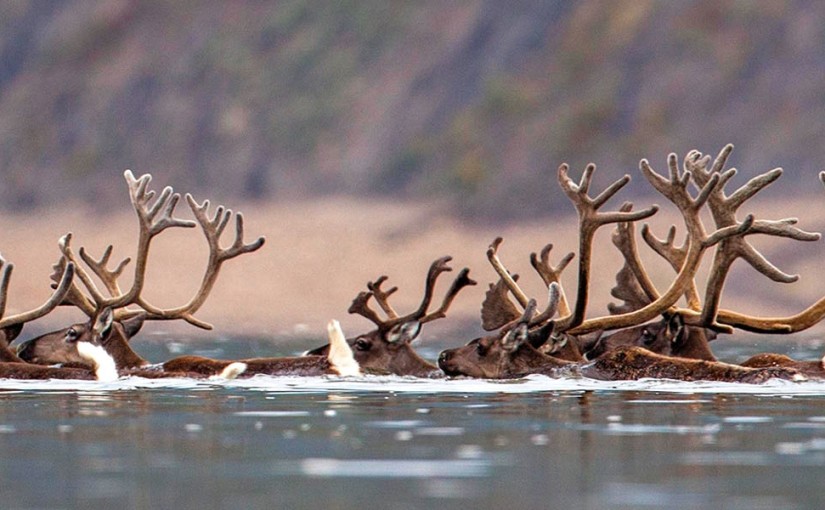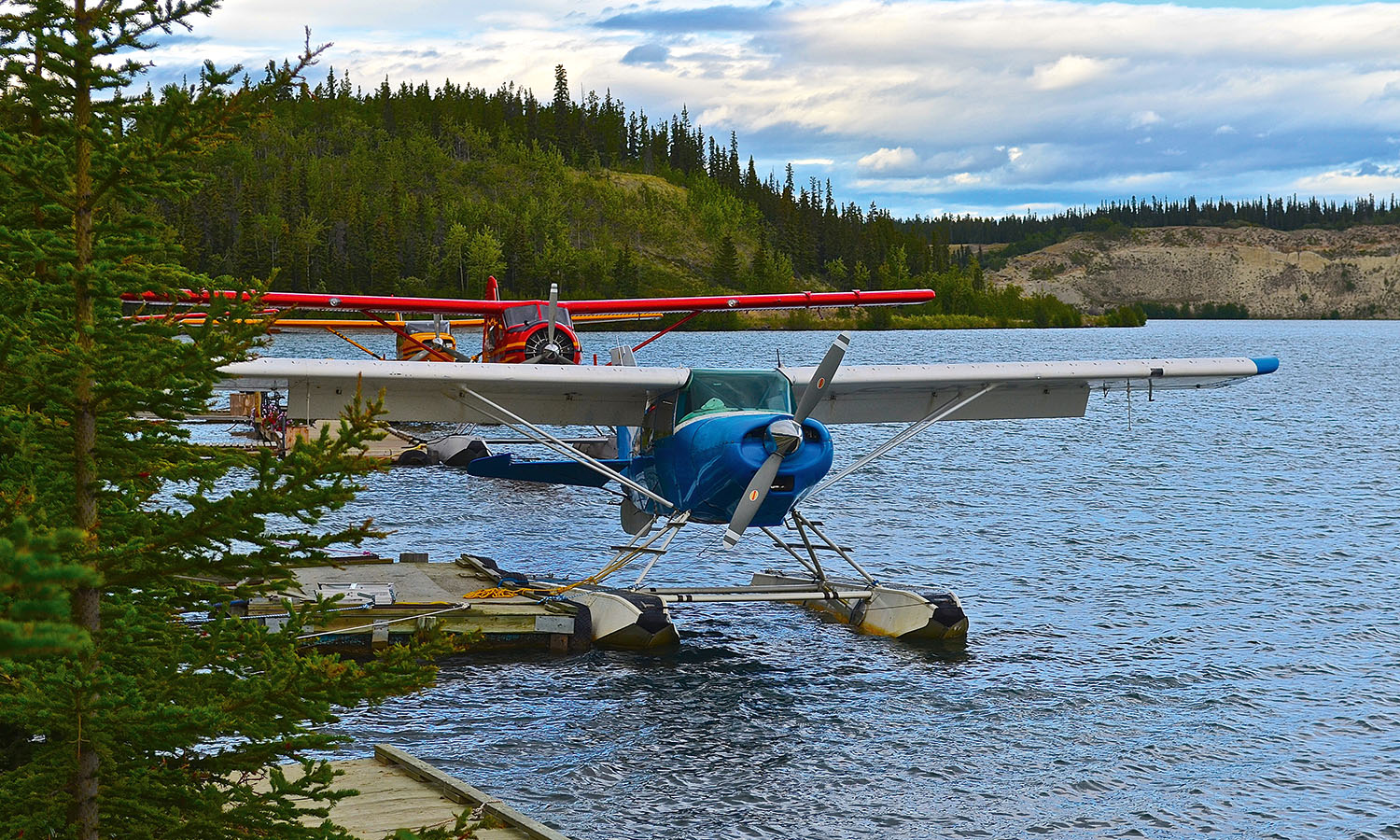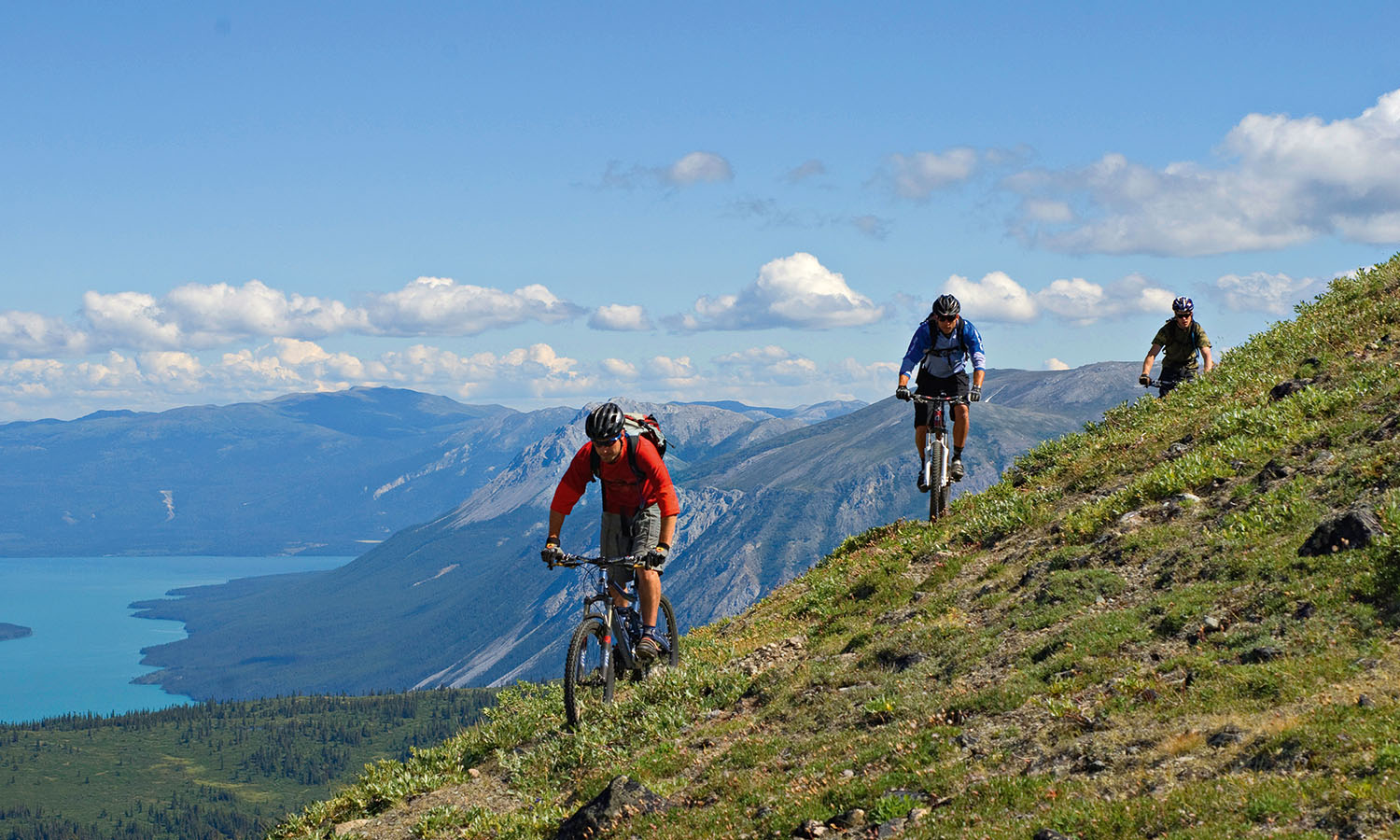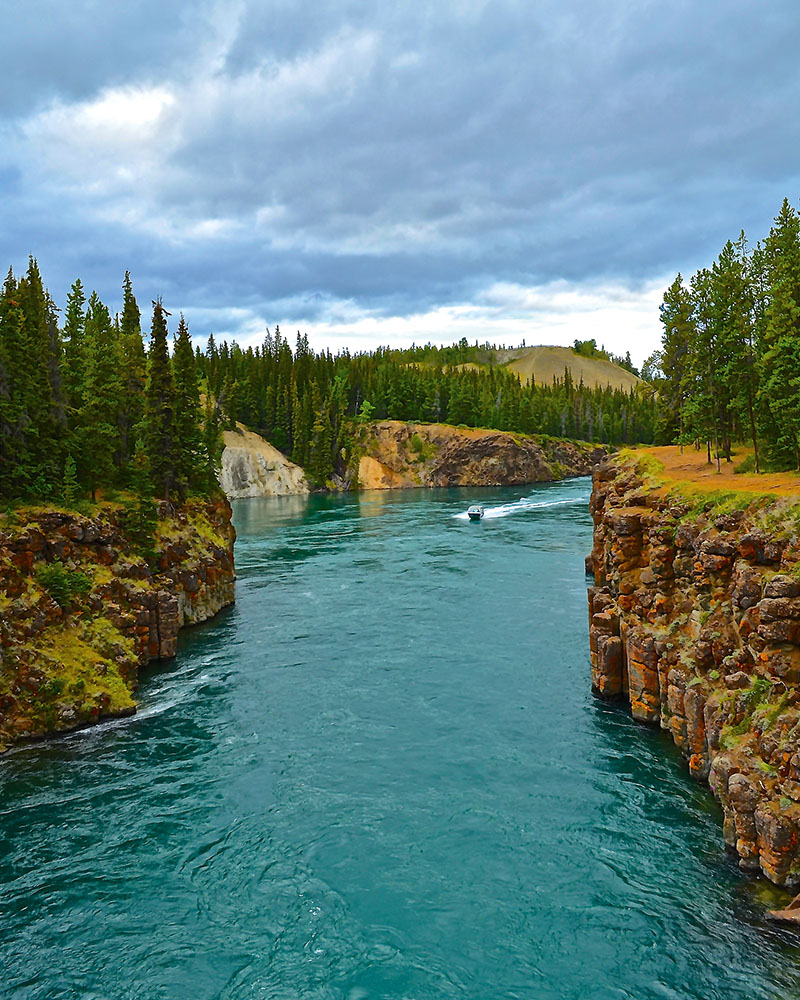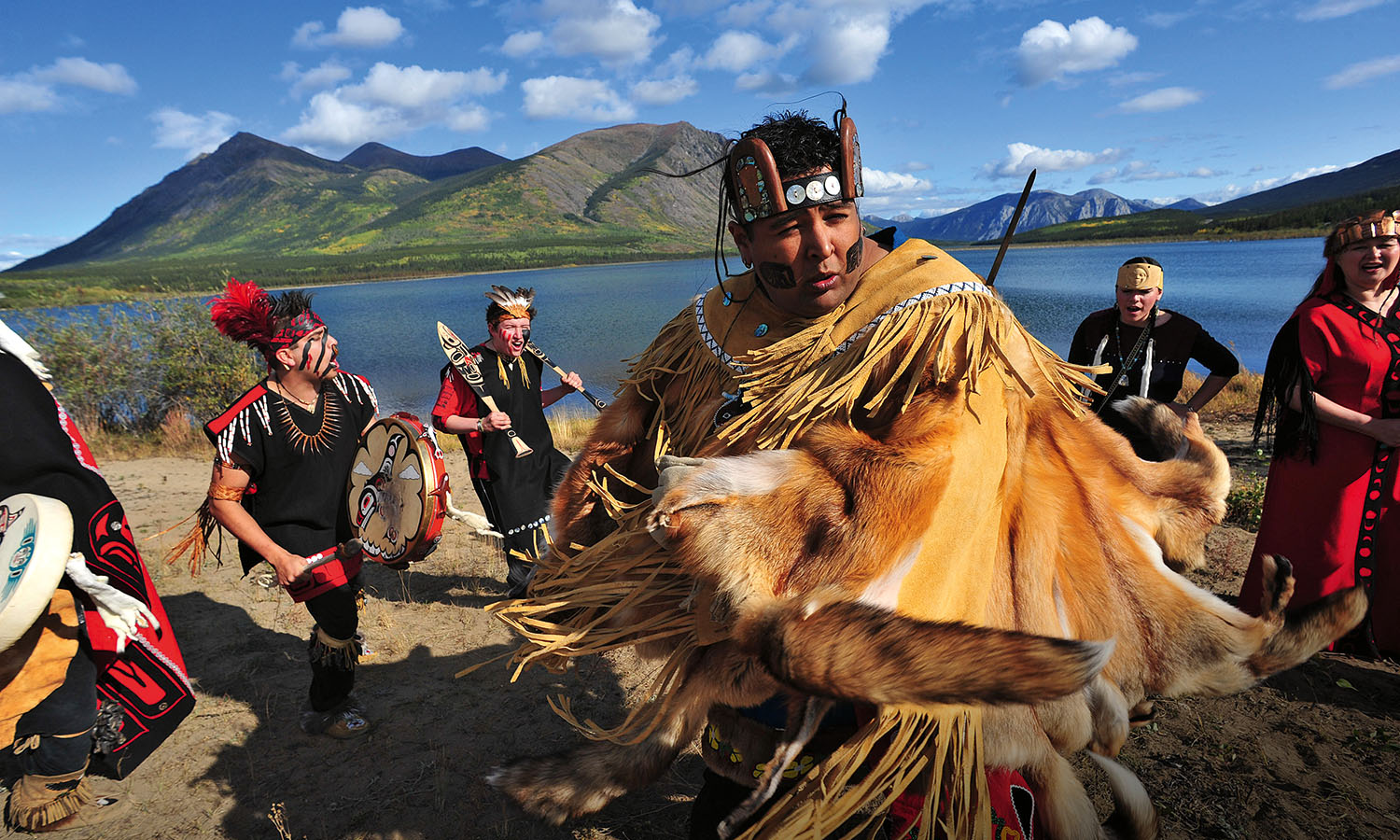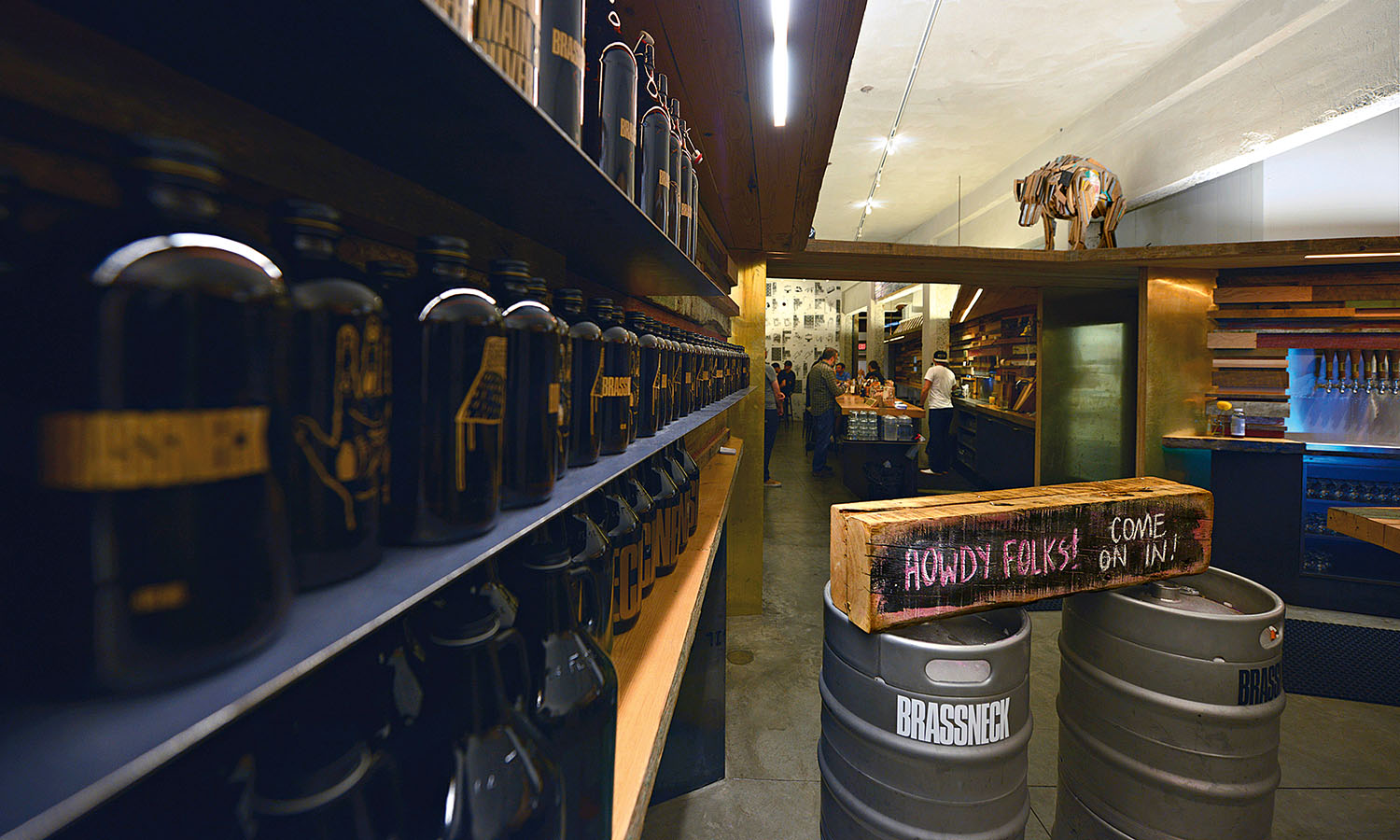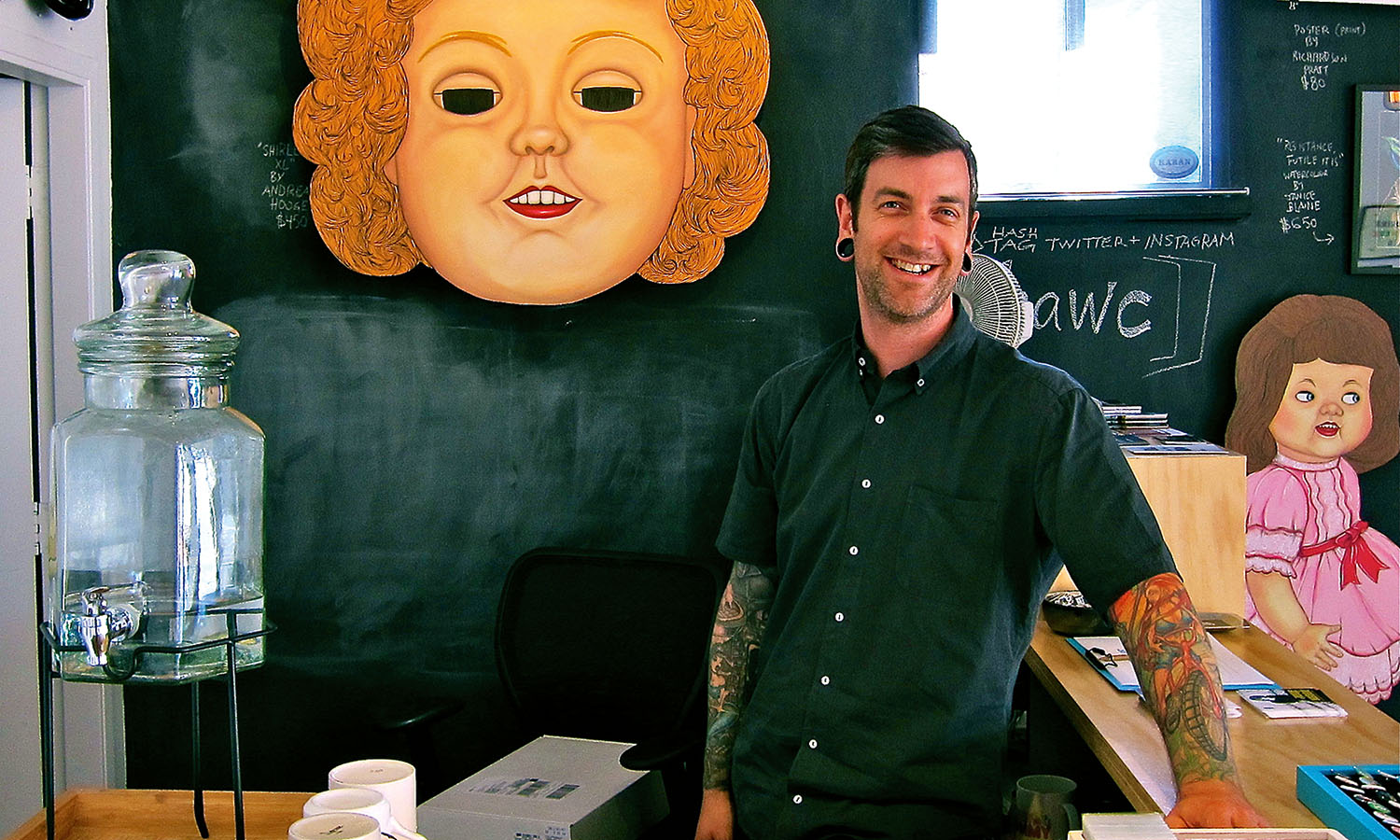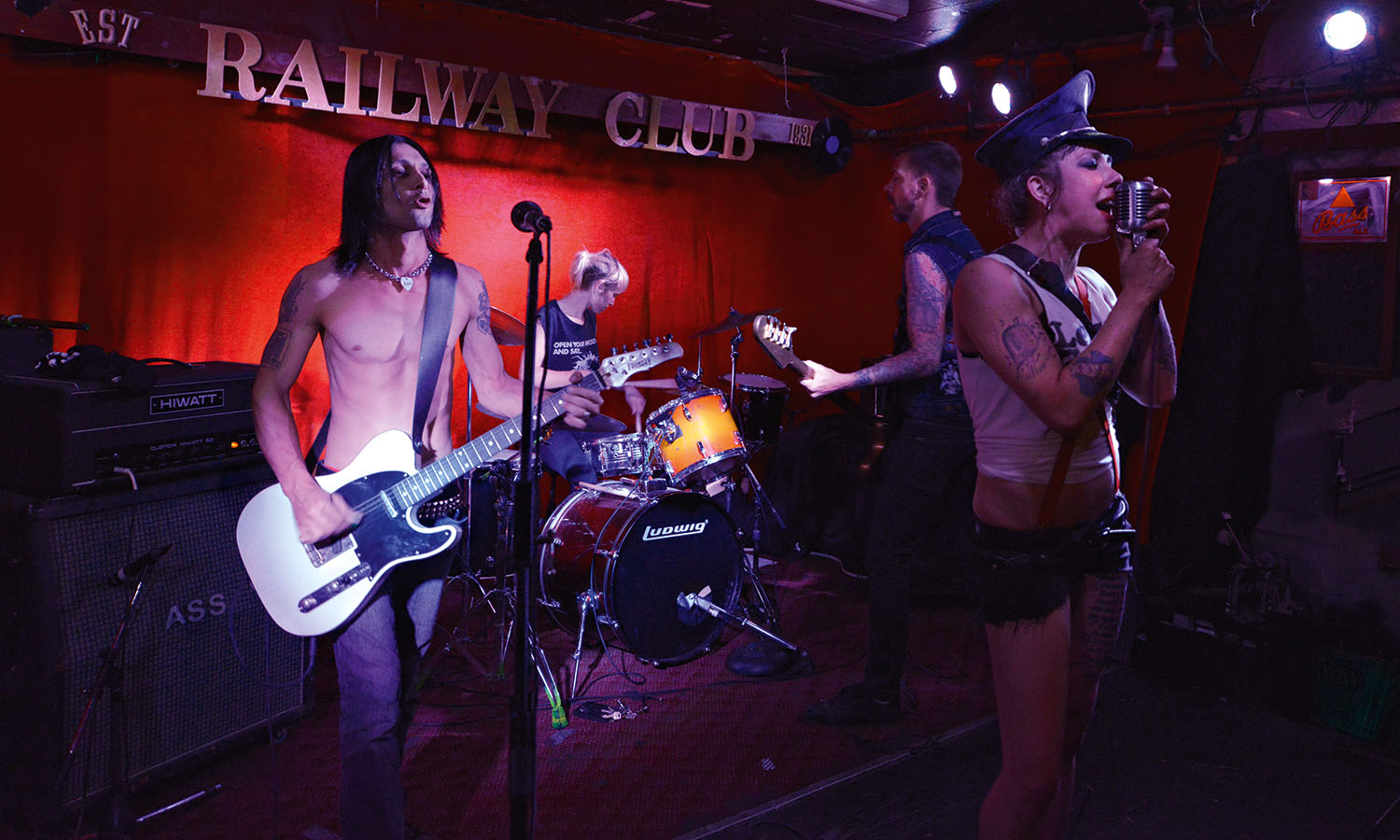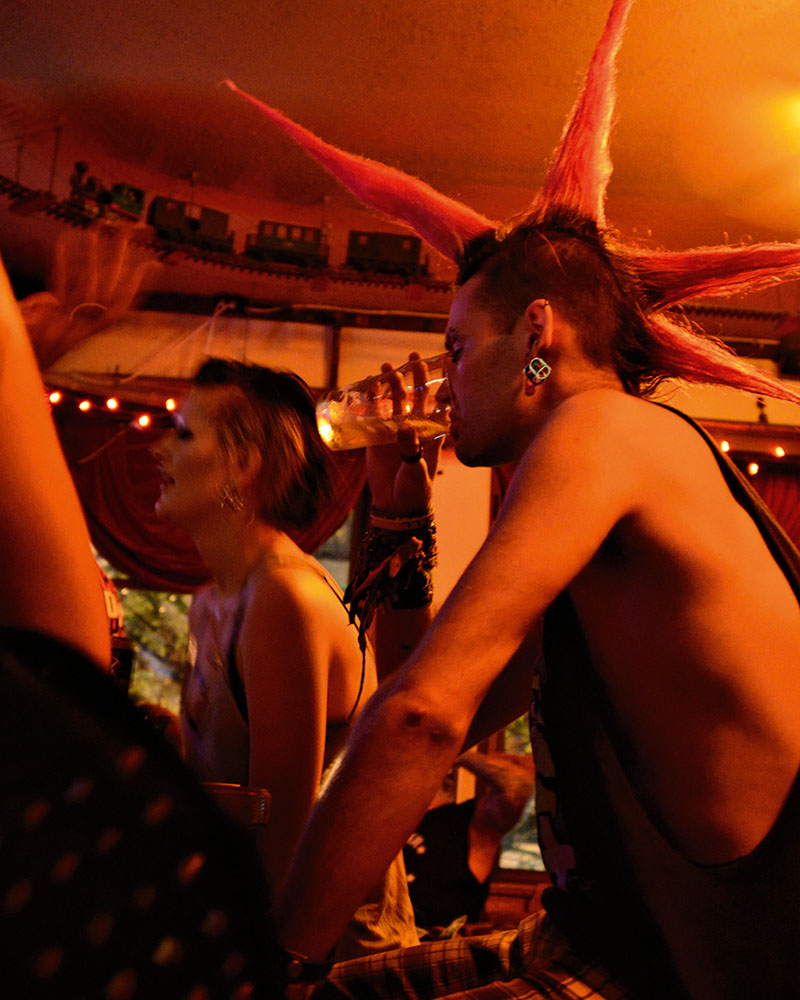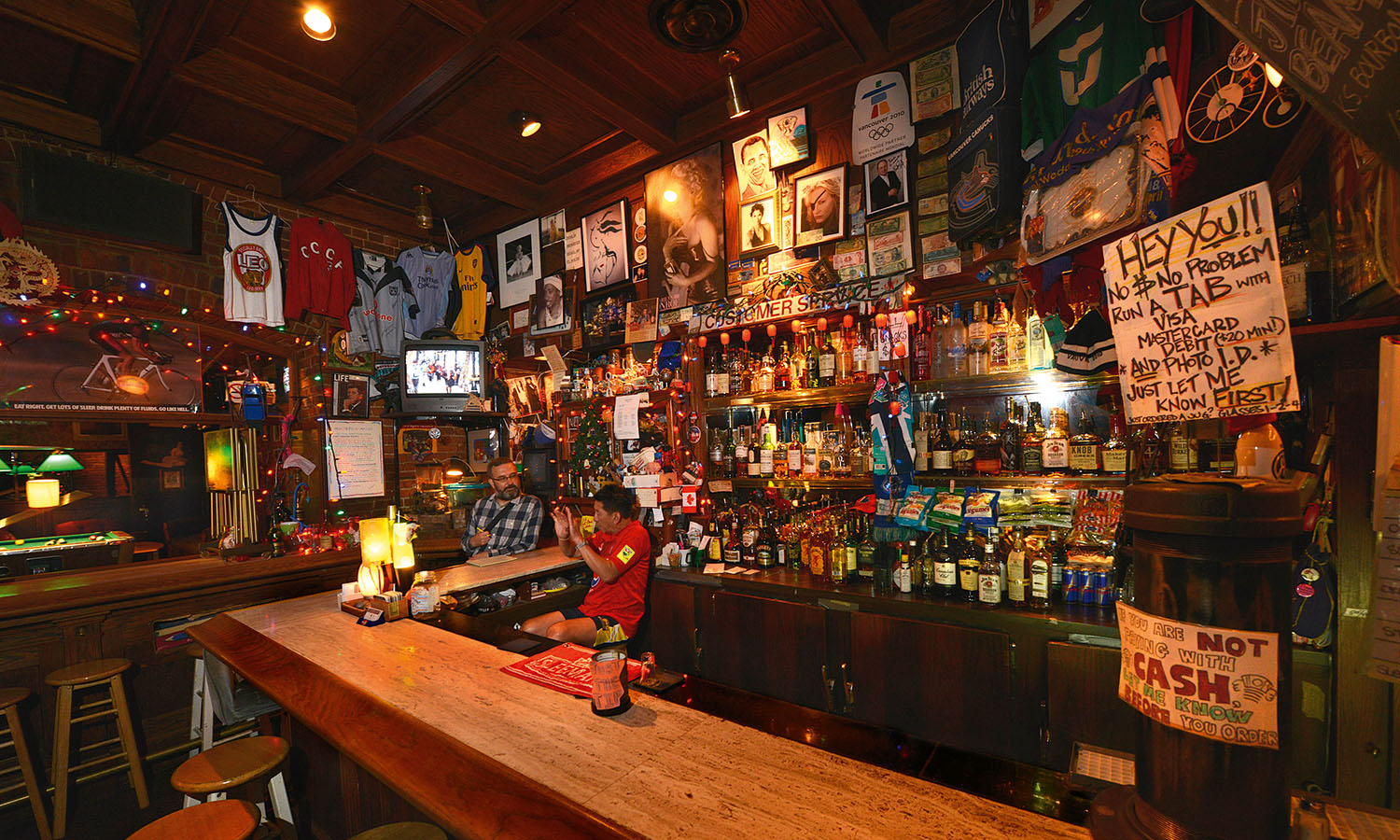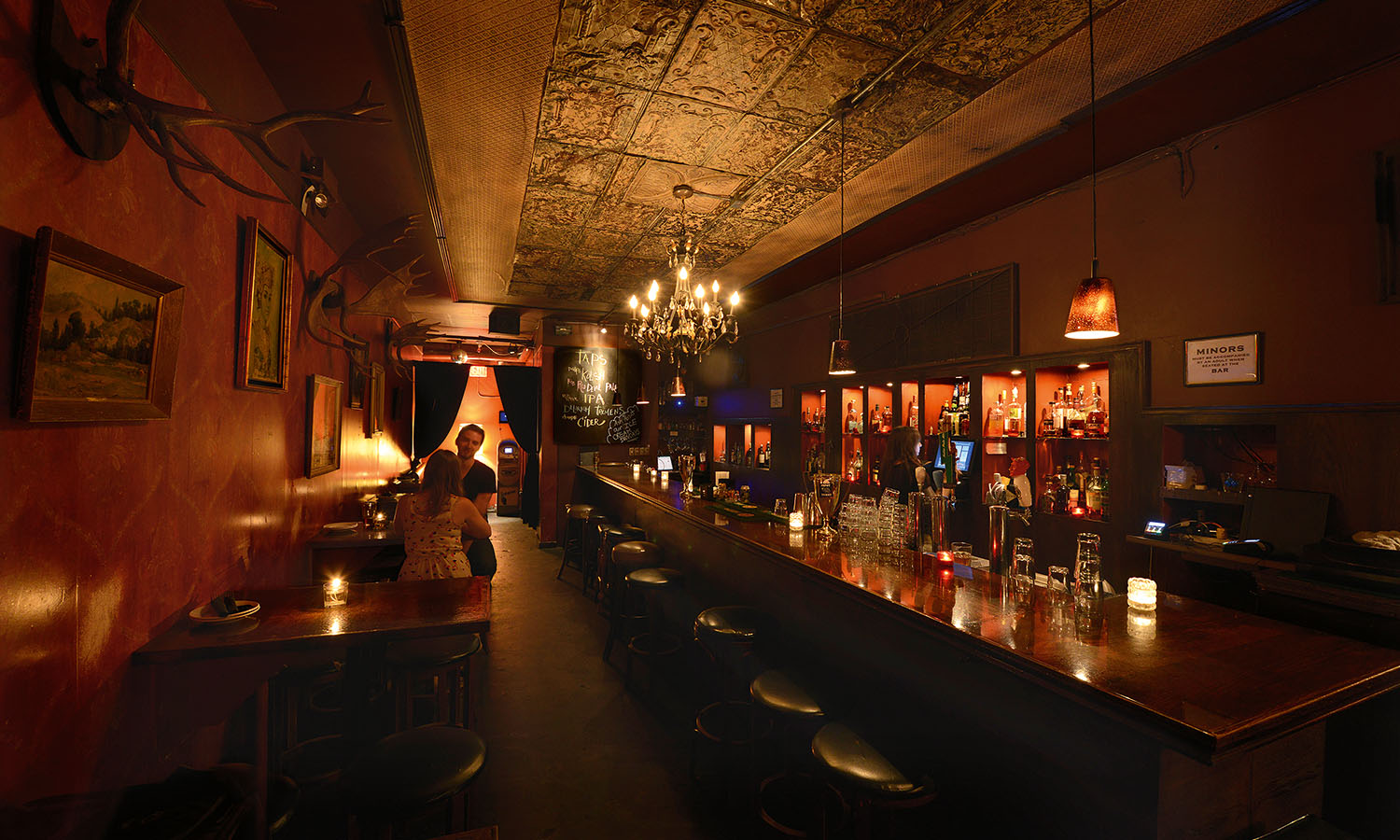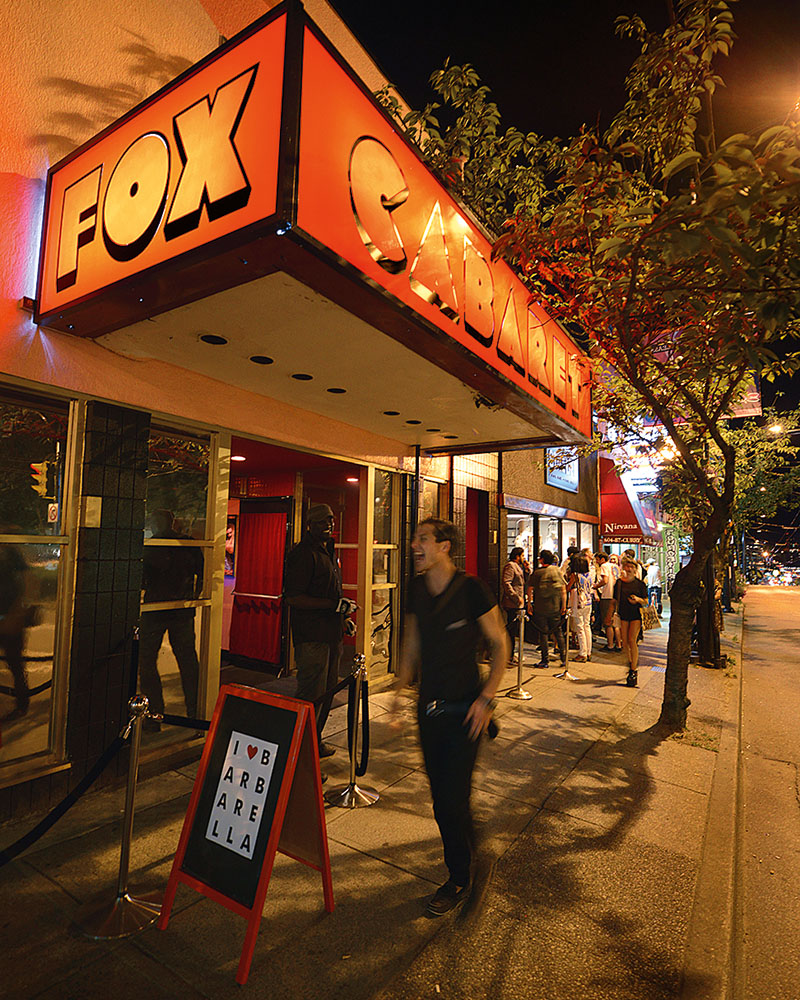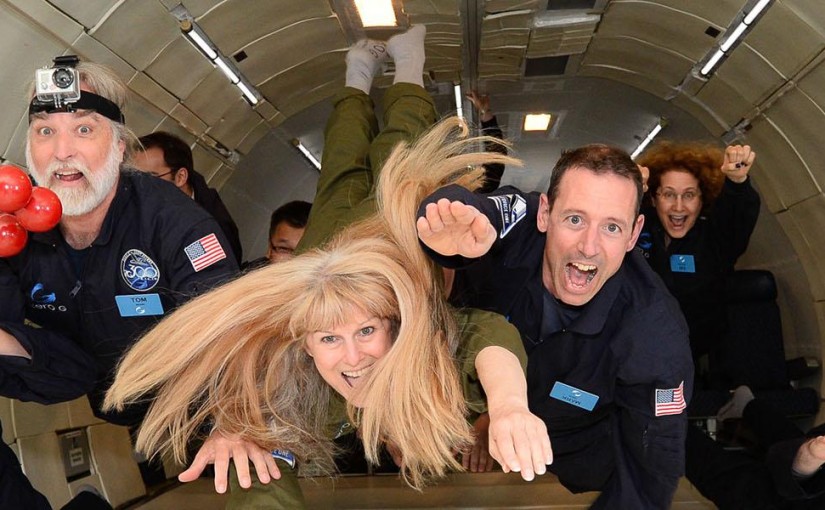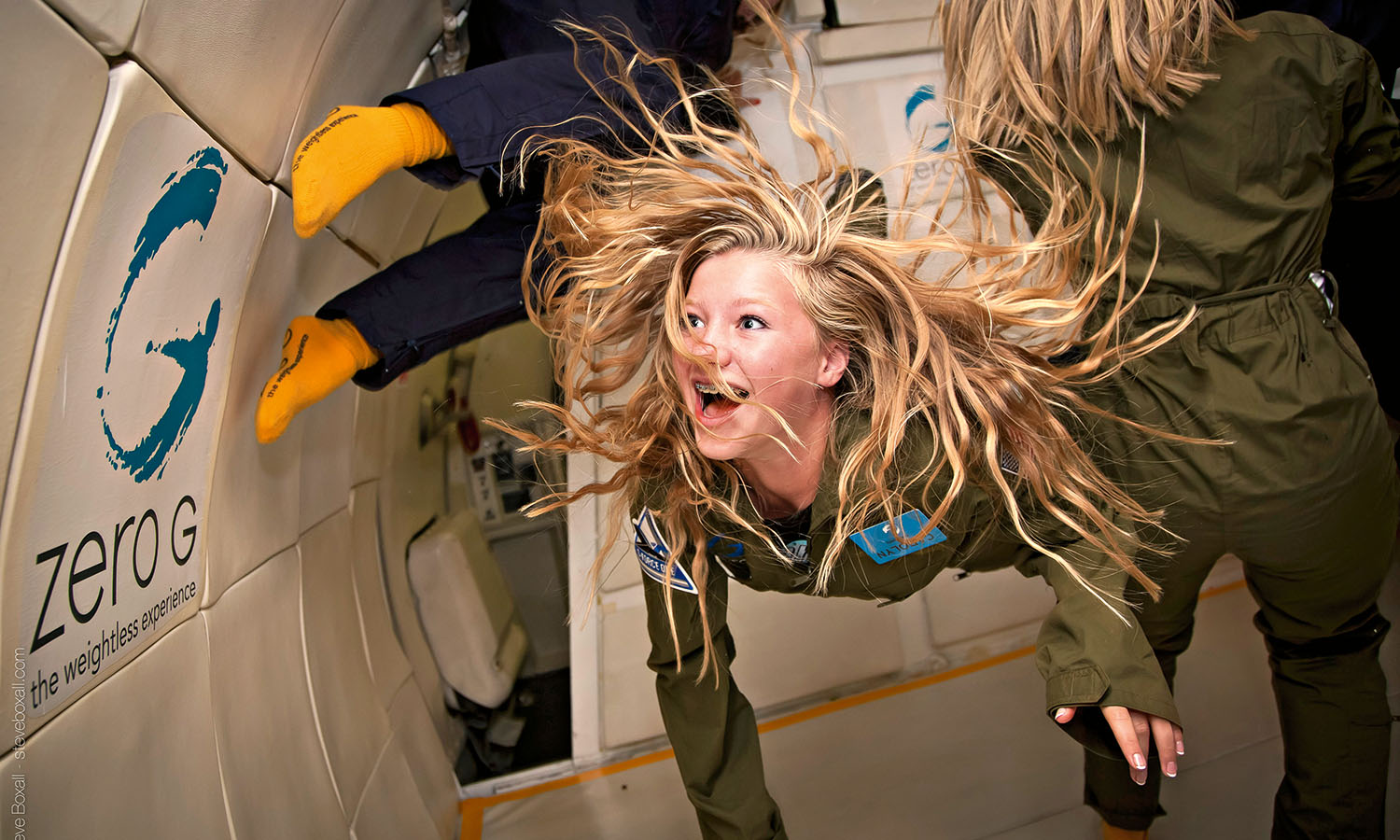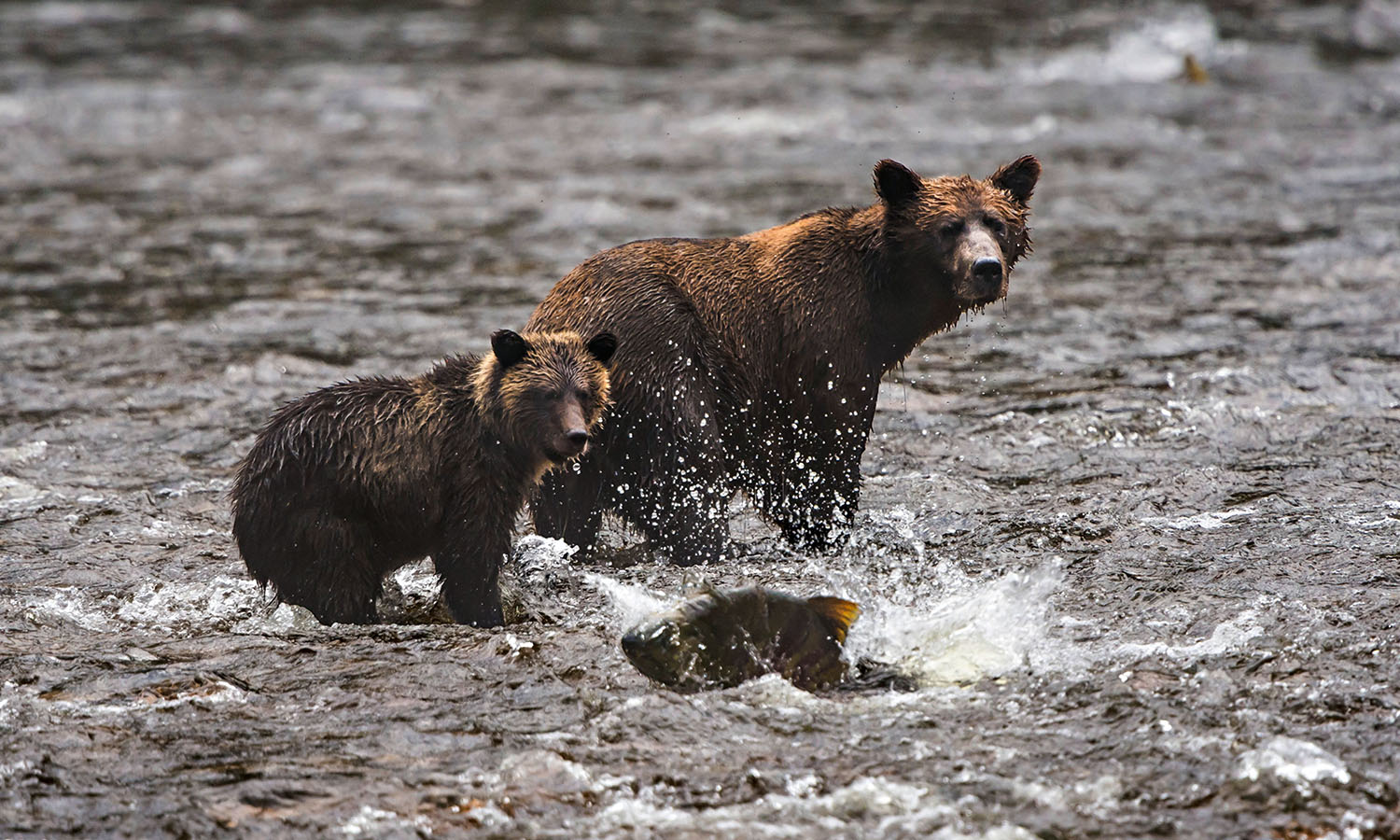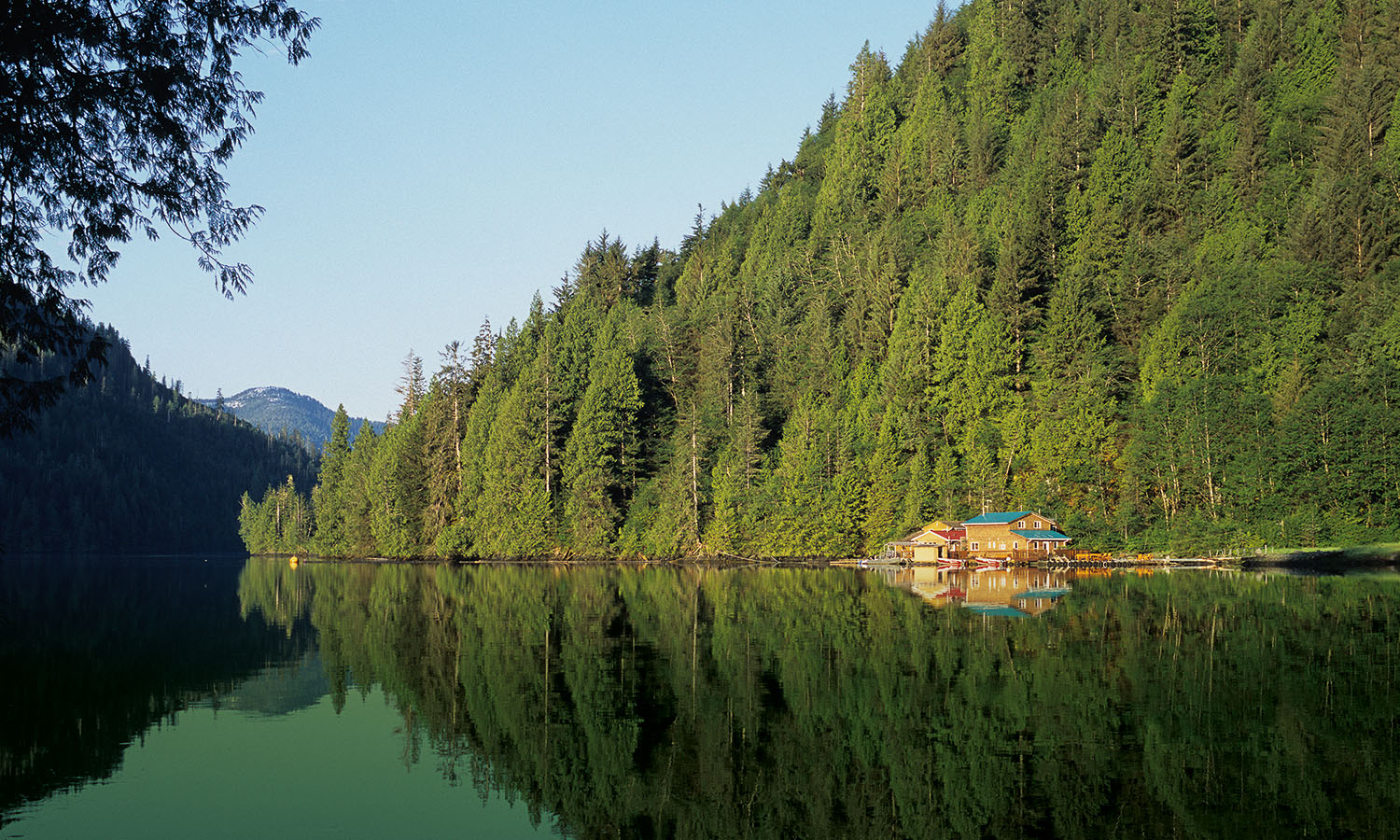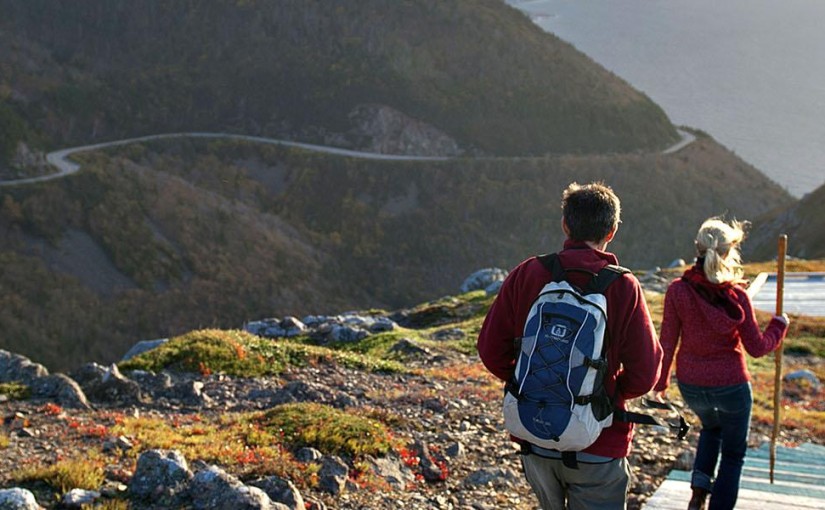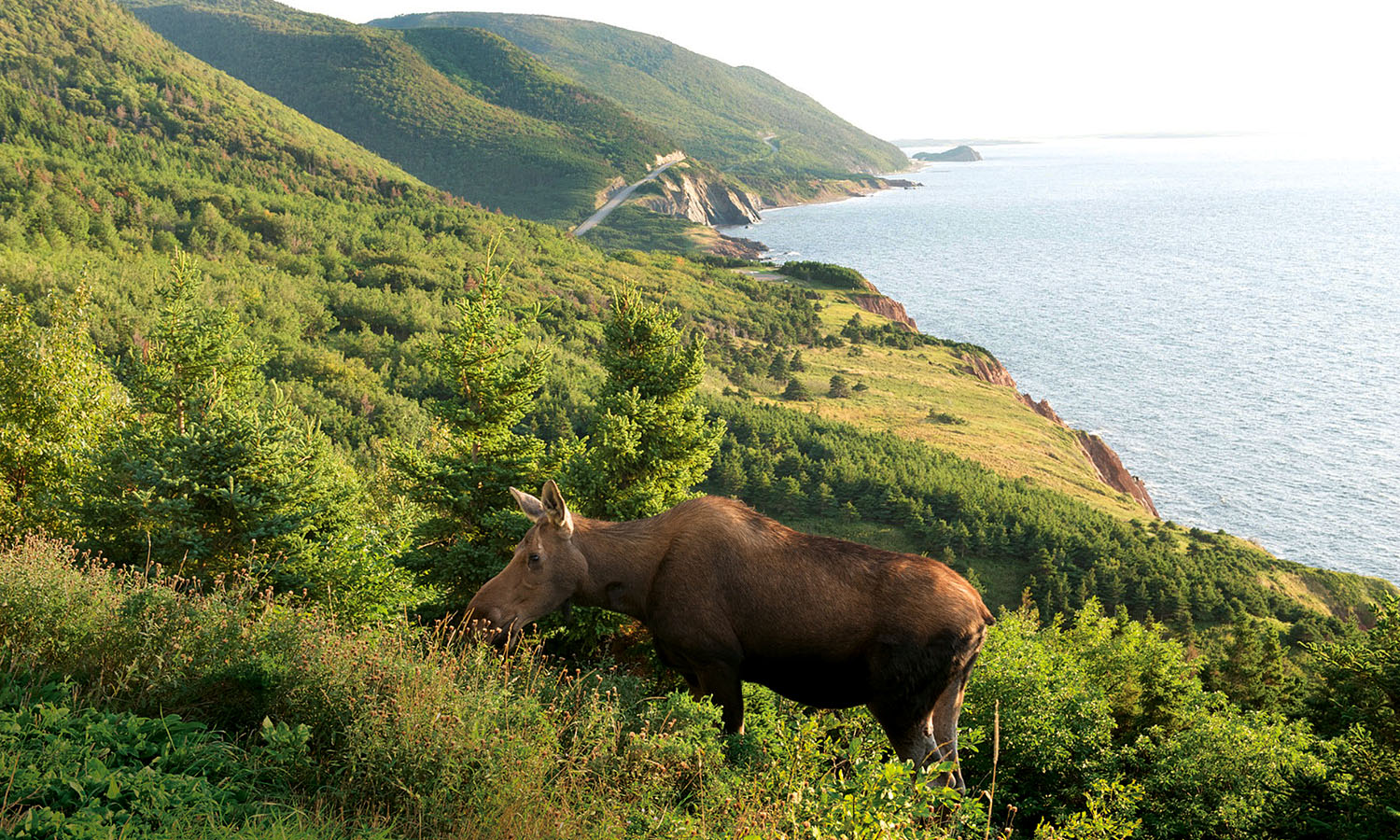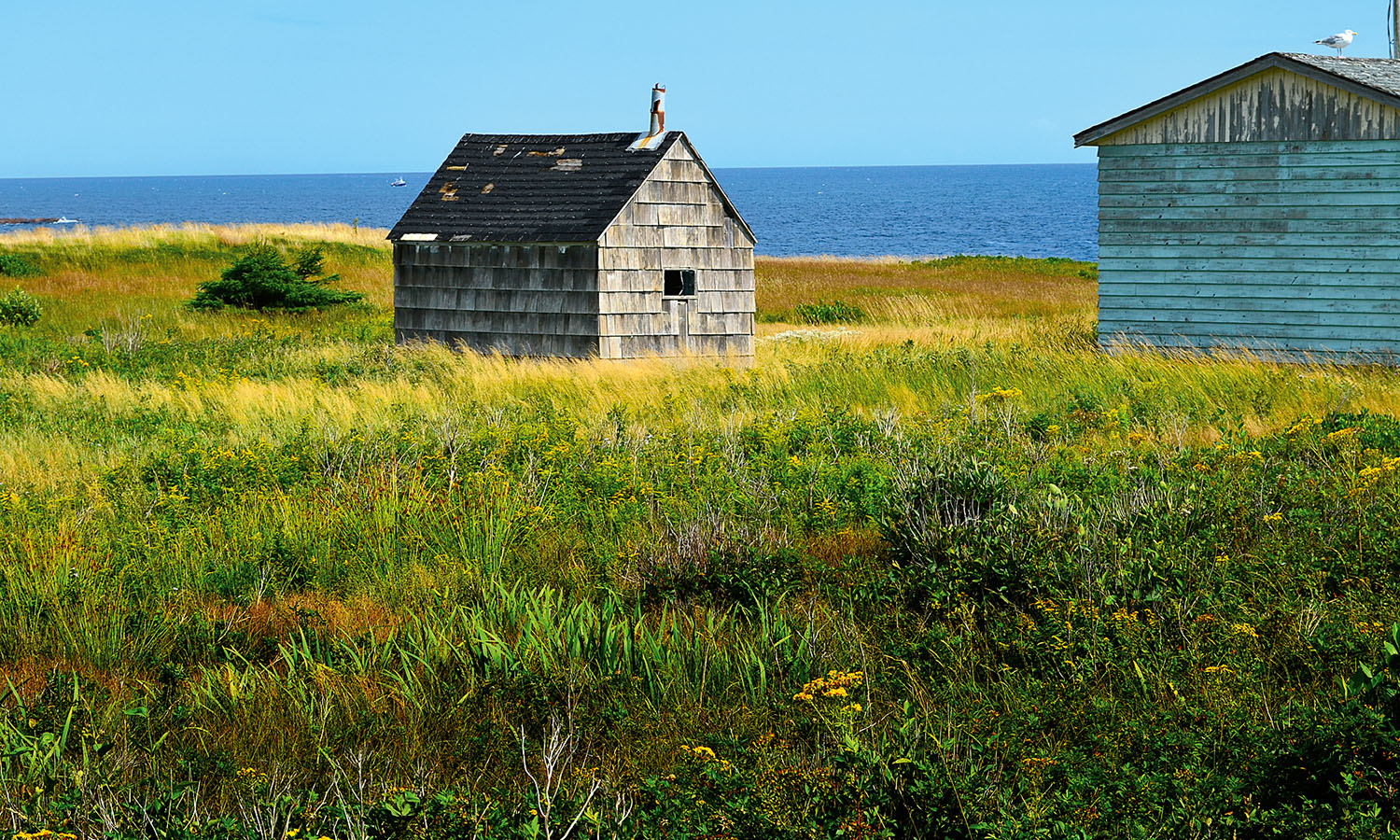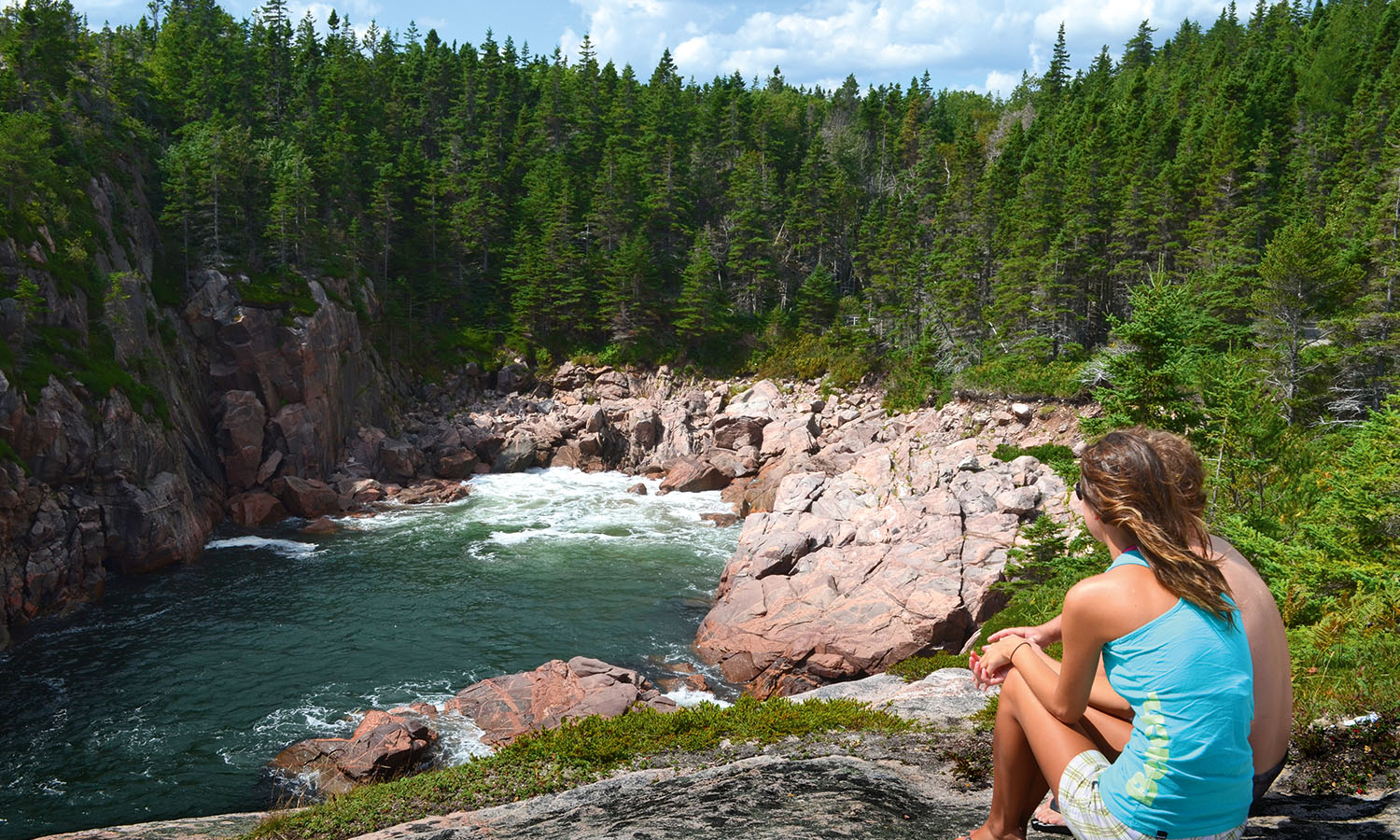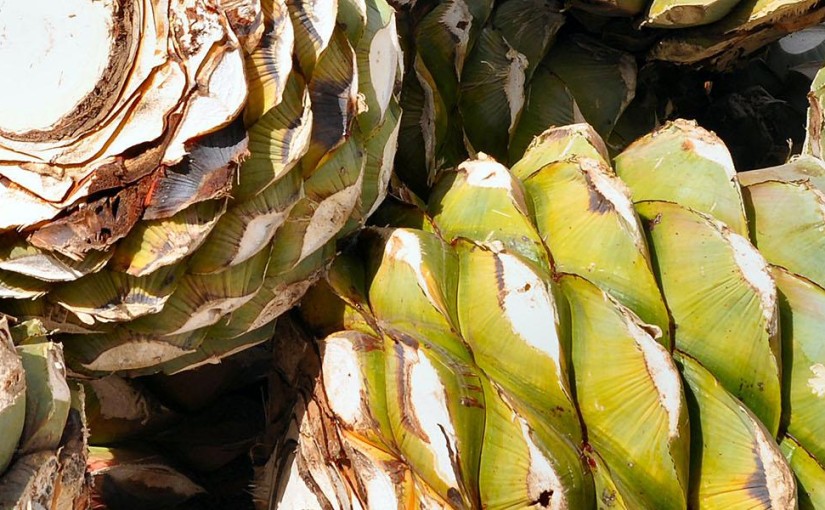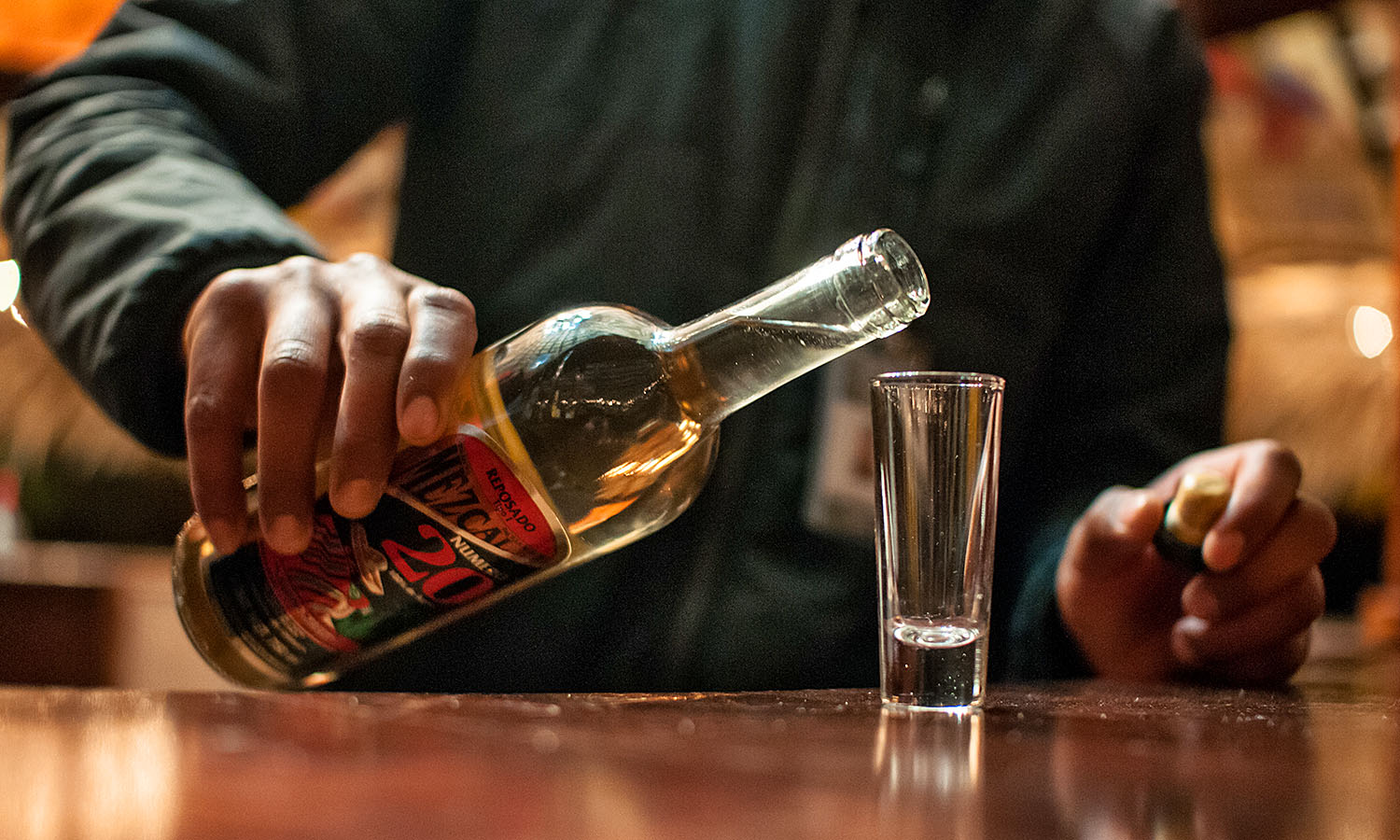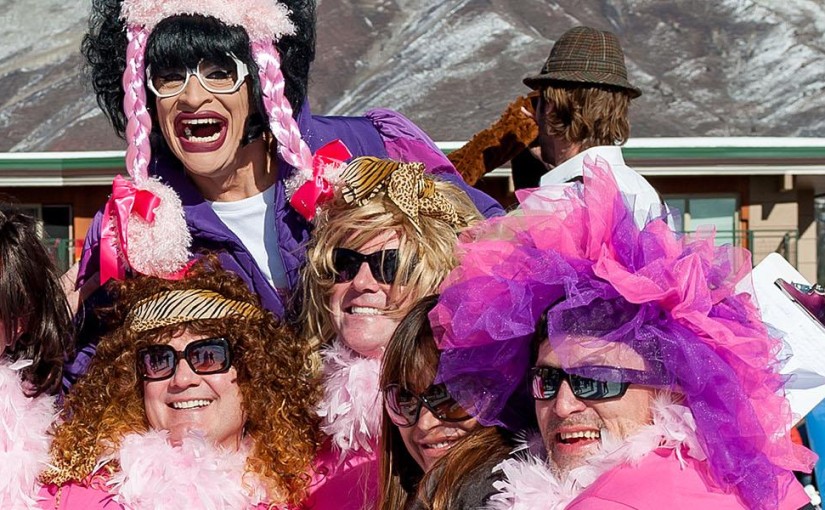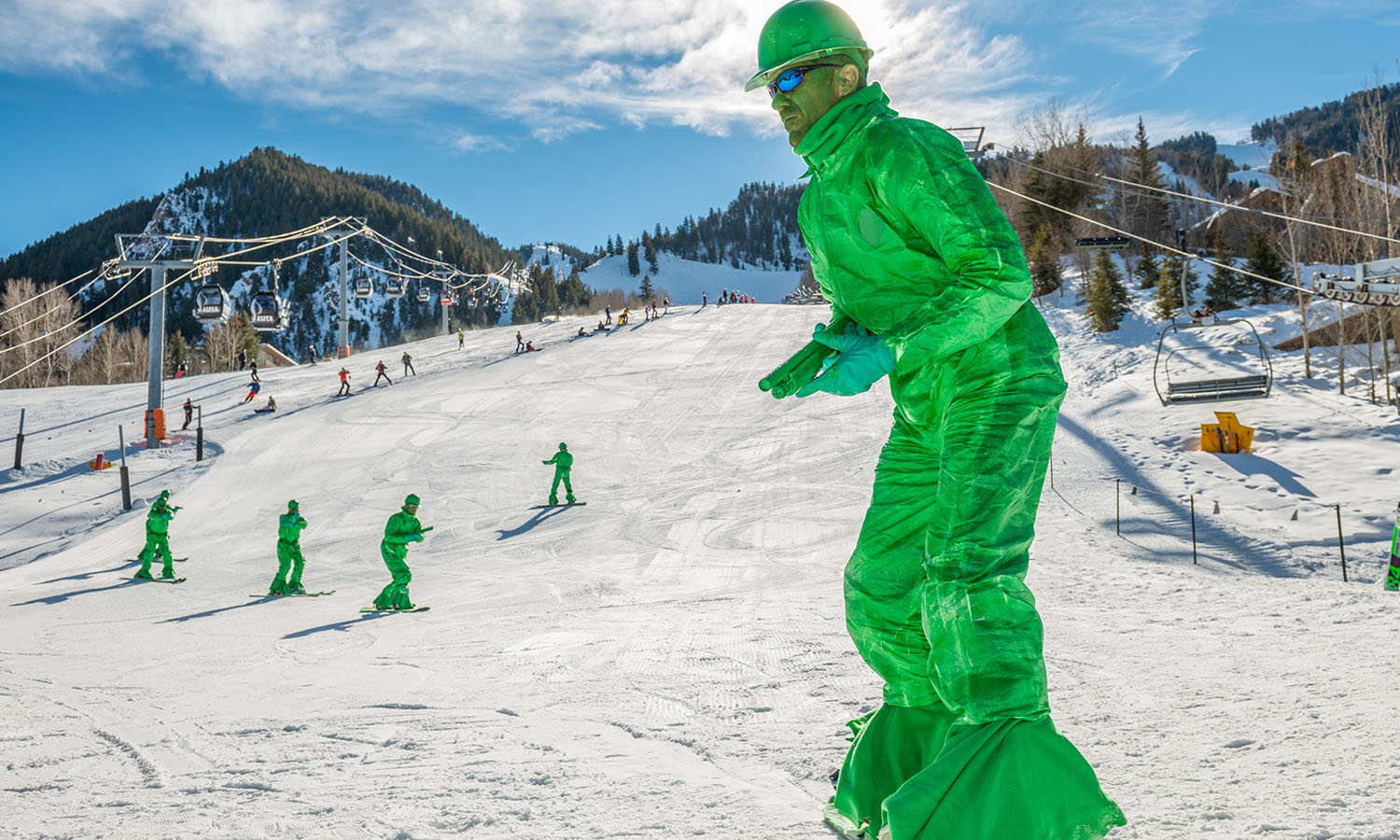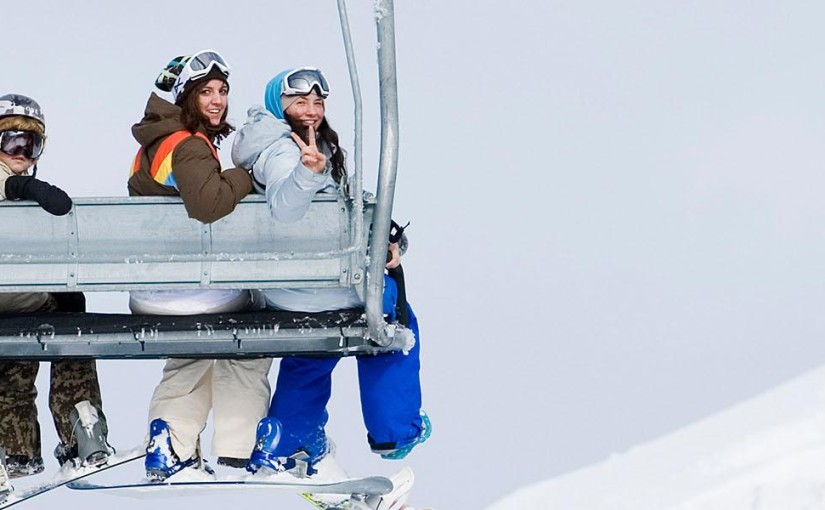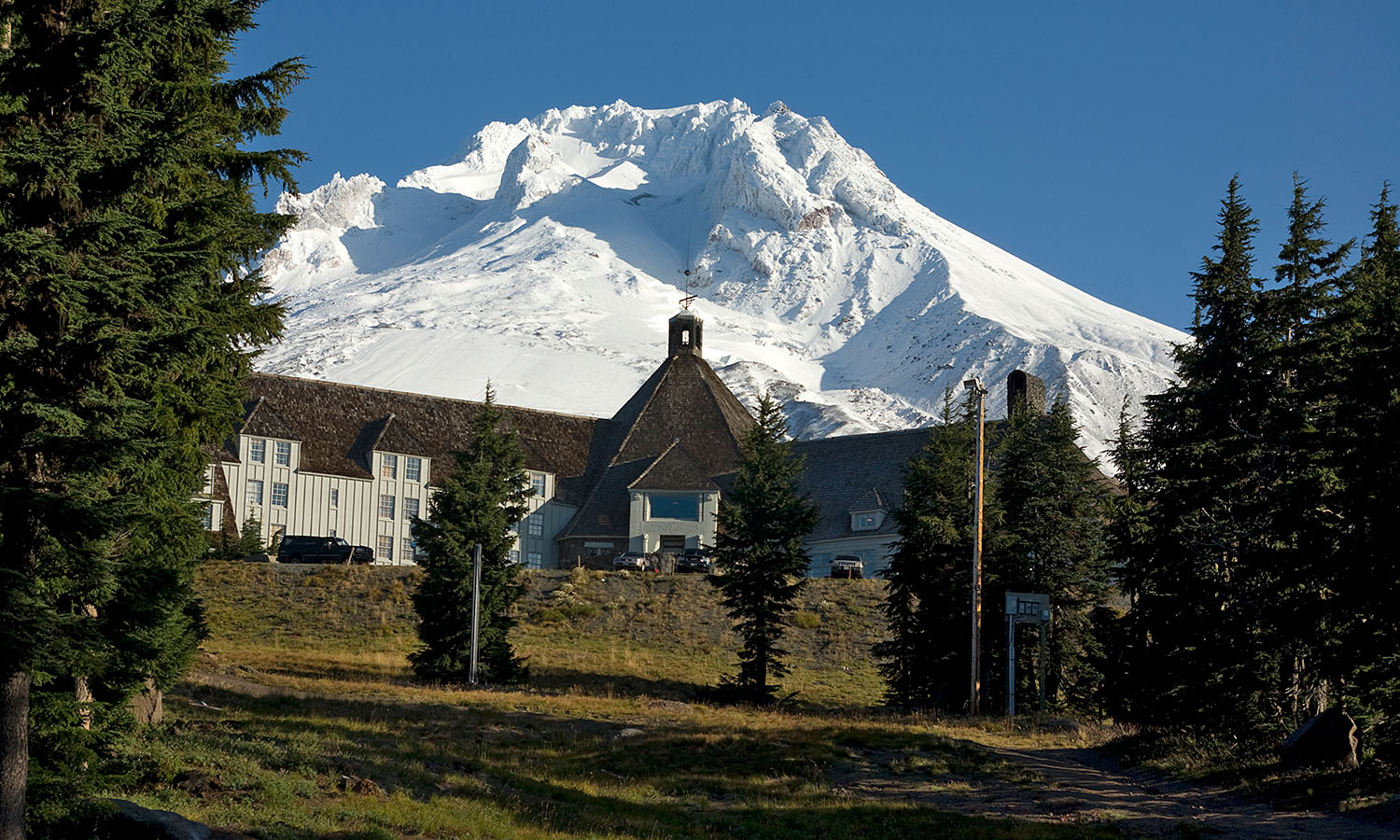A little further along we stop again. The muddy track is gouged into the sloping clifftop and slippery from the morning’s rain. It’s hairy going, so we get off and push until… Ziggy’s foot slides perilously close to the edge and shows no sign of stopping. Her bike’s following fast behind. She laughs and somehow halts the descent. “At least one person dies each summer in the river,” Ziggy says. “But it’s not gonna be me. I’d never live that down!”
And that’s another mark of a true Yukoner – irreverence. You see signs of it everywhere: on spray-painted buildings and locally made T-shirts and in conversations overheard on street corners in Whitehorse. Maybe it’s in reaction to the long cold winters, when temps drop to –50°C and romances blossom, only to wilt come the first warming rays of summer. “You’re a long time cold,” one old-timer tells me, “and a short time frisky and free.”
My week-long ride began here, in the ‘big town’ (population 26,500). Equal parts white settler and First Nation terrain, Whitehorse is perched on the banks of the Yukon River, named after the indigenous word for big river, youcon. Their ancestors used the river and the valley through which it flows as a meeting place and food bowl.
A two-hour flight north of the west-coast city of Vancouver, and bordering Alaska and the Arctic Sea, the Yukon Territory is home to 14 indigenous peoples and eight different language groups. The same size as South Australia, it has one-fiftieth of the population (30,000 people). In fact, you’re more likely to run into a moose than a person here – the antlered animals outnumber Yukoners two to one.
This wasn’t always the case. The Yukon population was higher in the gold rush years of 1898 and 99 than it is today. The Klondike Gold Rush began in 1897 and is the single biggest event – in terms of historical significance and population growth – in the Yukon’s history. When two ships docked in San Francisco and Seattle carrying miners returning from the Yukon with bags of gold, newspapers carried the story to the masses, and the masses responded in droves. Within six months, approximately 100,000 gold-seekers, called ‘stampeders’, set off for the Yukon. Only 30,000 completed the arduous trip.
There are fine Yukon ales on tap, a mummified cat in a glass box on the bar and rumours of ghosts swirling around like Casper himself.
The most common route was by boat from the west coast of the USA to Skagway in Alaska, over the hazardous Chilkoot or White Passes to the Yukon River then a hundred kilometres by boat to Dawson City.
Steep and perilous, the trail through Chilkoot Pass – 1500 steps carved out of snow and ice – was known as the ‘golden staircase’. Stampeders were required to take a year’s worth of supplies with them and, with the trail too steep for packhorses, they made up to 30 trips up and down the staircase, until all their goods were at the top. Many gave up, abandoning their equipment on the trail.
The White Pass track was even more challenging. More than 3000 pack animals perished here, causing it to be renamed the ‘dead horse trail’.
Stampeders who survived the passes reached Bennett Lake, where they wintered in tents waiting for the spring thaw. Then they would row their hand-built boats down the Yukon River to Dawson City. During the three-week trip miners rode killer rapids. Many lost their possessions, or worse, their lives, when their boats broke up.
Fortunately, my trip to the goldfields is far less taxing. From Carcross, an hour’s drive from Whitehorse, I jump aboard the historic White Pass & Yukon Railway. Built in 1898 to ferry miners, it offers a spectacular journey alongside pristine lakes and vertiginous mountains.
The snappily dressed train conductor welcomes me to the train. Then, in the comfort of my carriage, which features on-board wood-burning stoves, we chug along, drinking in the magnificent scenery – shimmering water, towering rock walls and lush greenery – through vast glass windows. The station in Bennett sits on the banks of the same lake that was choked with timber boats jostling for position in the gold rush race downriver.
During the stampede, a town sprung up around the lake. There were shops, saloons, a church and hotels, including the salubrious New Arctic Restaurant and Hotel built by opportunistic young businessman Friedrich Trump, who recognised that miners needed somewhere to spend their earnings. The fortune he made here in humble Bennett Lake gave rise to the famous Trump family empire, now known the world over.
Today, the remnants make for an intriguing historical site and the view is breathtaking – heavily wooded hills, cloud-tickling mountains and an exquisite turquoise lake. As I wander around, I imagine the lives of the stampeders, surviving what were undoubtedly some of the harshest conditions on the planet. Did the spectacular surroundings help pull so many of them through in the frozen winters spent in tents?
A day later I’m back in Carcross (short for Caribou Crossing) and hurtling down Montana Mountain, a mix of rugged terrain, pine forests and rock.
I’m warming up my cycle legs on the green and blue trails (rated similarly to ski trails), before steeling myself to tackle Upper Wolverine – a rock garden maze with raised wooden features and natural airs. If I have any pedal left and am willing to throw all caution to the wind, I might even visit Grizzly Bear. As aggressive as its namesake, Grizzly is a steep descent along smooth rock faces and buff dirt, with some hair-raising lines.
Here, there is a combination of historic trails, mining-era routes and a single purpose-built track (35 kilometres in total). All are maintained by dedicated trail builders, courtesy of the Yukon government.
So passionate are locals about mountain biking that it’s not only adults who ride, build and maintain trails. The owners of Boreale Biking, through whom I hired my bike and hooked up with guide Ziggy, run weekly kids’ mountain-biking days.
“We teach the kids how to ride and also get them involved in building trails and maintaining them, so they’re giving back to the community,” owner and mountain-biker Marsha says. “It’s an involvement they’ll carry through to adulthood, we hope, along with a passion for getting out among it. As we always say, any day in the saddle’s a good day!”
It’s a great program and the kids love it – throwing themselves down trails all morning, switching handlebars and helmets for shovels in the afternoon, and rounding out the day with a barbecue under the midnight sun.
The 20-plus hours of daylight in high summer mean there’s plenty of time for trail riding and a multitude of other outdoor sports in the Yukon.
After my morning on Montana I trade saddles – bike for horse – and head into the high alpine. Slowly and sure-footedly we climb through dense forest to emerge above the tree line and gaze out over shimmering Fish Lake. Behind me, to the north, a line of jagged mountain peaks iced with snow claws its way to the horizon and, beyond that, Alaska.
The following day I hike to the top of another mountain range, and the day after that am pulled along behind a team of newbie sled dogs in training for the winter season. Like the locals, I’m making the most of the summer.
Also like a local, I’ve developed quite a thirst, and so Ziggy and I head to the Dirty Northern Bastard in the heart of Whitehorse. There are fine Yukon ales on tap, a mummified cat in a glass box on the bar and rumours of ghosts swirling around like Casper himself.
“The story goes that the original hotel, the Capital, closed down years ago in the winter and everyone moved out,” says Ziggy. “In the spring, people started smelling something rotten and when they investigated they found a former guest thawing out in his room. And the cat, well, it was found in the walls of the hotel when it was being restored. It had been there so long it was completely mummified. Today, it’s said they wander the halls and rooms of the hotel.”
Ziggy’s stories are a blast and soon other locals join in with tall tales and truths about Yukoner life.
 (
(
